Welcome to Muktinath Temple, a place of deep religious significance and unparalleled natural beauty. Muktinath is a sacred site for both Hindus and Buddhists, located in the Mustang district of Nepal. It is situated at an altitude of 3,762 meters (12,342 feet) in the Annapurna mountains and is one of the most popular tourist destinations in Nepal.

The temple is located in a remote and beautiful valley in the Himalayas. It is a small and whitewashed structure with a golden roof. The temple is surrounded by 108 water spouts, which are said to possess healing powers.
Hindu Significance
In Hinduism, Muktinath is considered one of the eight most sacred places and is known as the “Place of Liberation.” The temple is dedicated to Lord Vishnu. The 108 water spouts are said to represent the 108 sacred places of pilgrimage in Hinduism, and bathing in them is said to cleanse the soul.
Buddhist Significance
In Buddhism, Muktinath is considered to be one of the 24 most important tantric sites. The temple is said to be the place where Guru Rinpoche, also known as Padmasambhava, meditated and achieved enlightenment.
History of Muktinath Temple
The name Muktinath means a place of salvation in Sanskrit. Believers consider the temple dedicated to Vishnu one of the eight most significant pilgrimage sites in Hinduism.

Highlights of Muktinath Temple
Let’s take a look at the main attractions of Muktinath Temple, from its sacred sites to the awe-inspiring natural wonders that make it a must-visit destination.
1. Muktinath Temple Complex
The focal point of the region, the Muktinath Temple complex, captivates with its breathtaking beauty. Built in pagoda-style architecture, the temple stands as an exquisite example of Nepali craftsmanship. Its golden pinnacle, adorned with prayer flags fluttering in the mountain breeze, adds a vibrant touch to the serene surroundings.

As you step into the complex, an aura of devotion and spirituality immerses you, enhanced by the melodic chants and prayers filling the air.
2. Jwala Mai Temple and Eternal Flame
Adjacent to the main temple, you’ll find the Jwala Mai Temple, housing an eternal flame that has been burning for centuries.
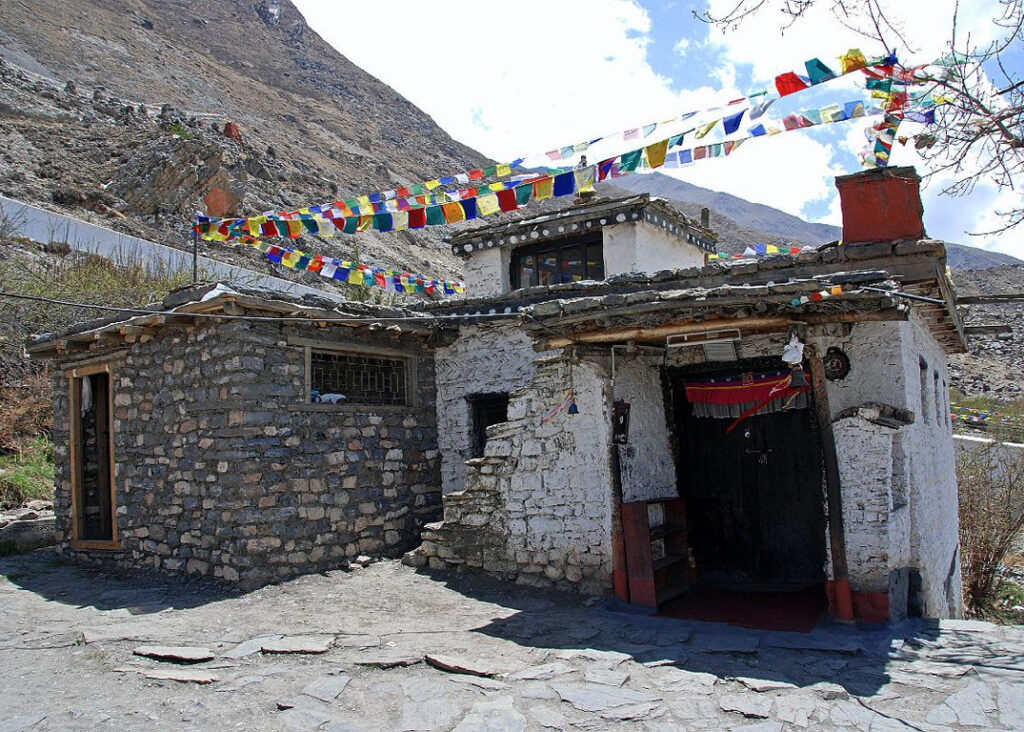
The natural gas flame emerging from a rock formation is regarded as a divine manifestation of the Hindu goddess. It is an awe-inspiring sight that symbolizes the eternal energy and power of the divine, leaving visitors spellbound by its mystical allure.
3. 108 Sacred Water Spouts
The 108 spouts of Muktinath Temple in Nepal are a captivating sight for pilgrims and visitors alike. These stone water taps, known as Mukti Dhara, hold deep religious significance. They represent sacred water sources mentioned in ancient Hindu scriptures. The icy-cold water flowing incessantly from these spouts is considered highly pure and cleansing.

Devotees come from far and wide to take a holy bath and seek spiritual purification, believing it washes away their sins and brings them closer to salvation. The 108 spouts of Muktinath serve as a powerful symbol of devotion and the eternal quest for spiritual liberation.
4. Buddhist Monastery
Adjacent to the Hindu temple, there is a Buddhist monastery that adds to the spiritual diversity of Muktinath. The monastery, dedicated to Guru Rinpoche, provides a serene and meditative atmosphere for both monks and visitors seeking spiritual solace.

The intricate Tibetan-style artwork, the peaceful ambiance, and the presence of devoted monks engrossed in their daily rituals create a sense of tranquility and introspection.
5. Natural Beauty of Mustang
Muktinath Temple is located in the Mustang district and is renowned for its captivating natural beauty. The region is a paradise for trekkers, offering awe-inspiring trails through barren landscapes, deep gorges, and snow-capped peaks.

The Kali Gandaki River, flowing near the temple, presents a mesmerizing sight. The grandeur of the Dhaulagiri and Nilgiri mountain ranges further enhances the enchanting backdrop, providing ample opportunities for breathtaking photography and unforgettable memories.
Read: Upper Mustang Trek via Dolpo
6. Kagbeni Village
Located near Muktinath Temple, Kagbeni Village is a charming settlement that provides a glimpse into the traditional Mustang way of life. The village is famous for its unique architecture, with houses built in a distinctive Tibetan style using mud, stone, and timber.
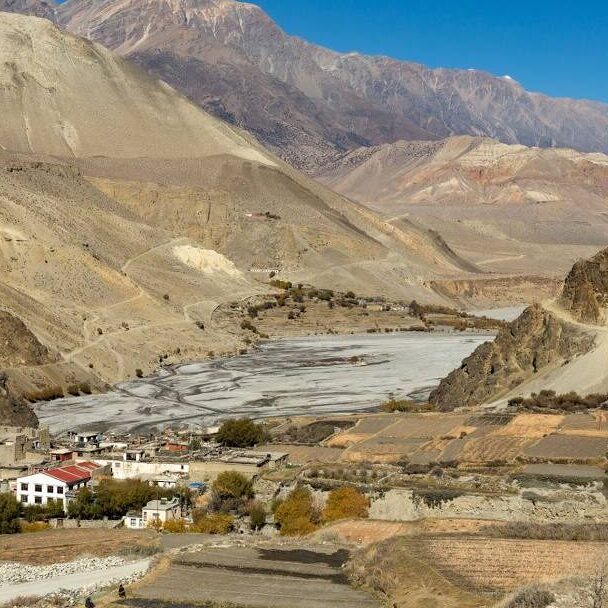
The ancient monastery of Kag Chode Thupten Samphel Ling is a highlight, with its intricate murals and a peaceful atmosphere that invites visitors to immerse themselves in the local culture and spirituality.
7. Local Festivals
Muktinath Temple and its surrounding villages come alive during festive occasions, offering visitors a chance to witness and participate in vibrant cultural celebrations. The Yartung Horse Festival, held in August, showcases traditional horse racing, archery competitions, and lively folk dances.
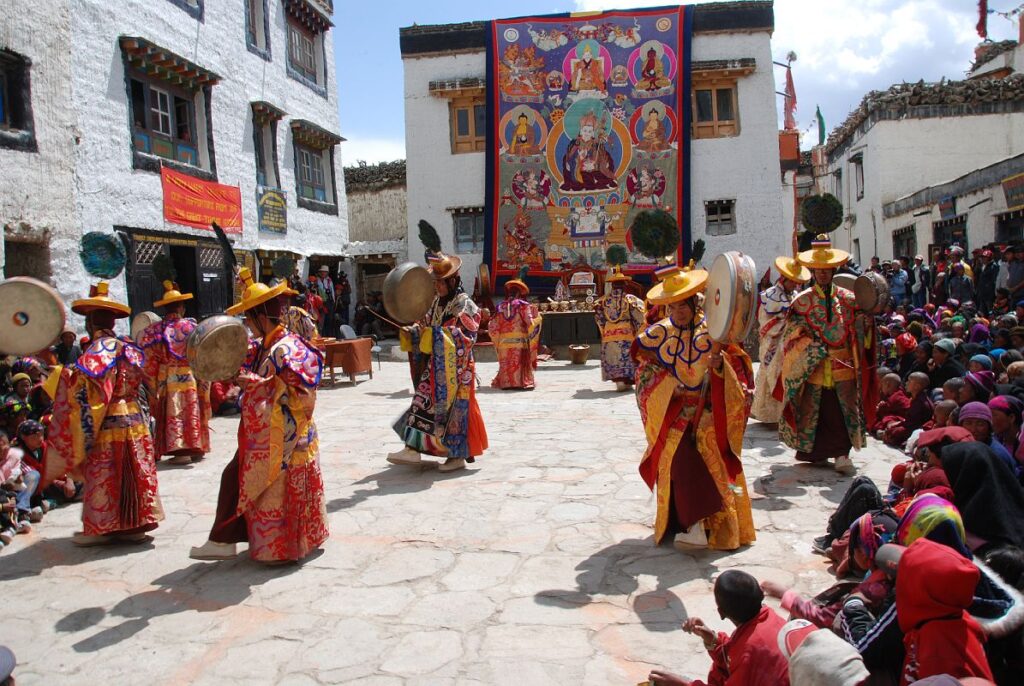
The Tiji Festival, celebrated by the local Tibetan Buddhist community, involves vibrant masked dances and ancient rituals that depict the triumph of good over evil. These festivals offer a fascinating insight into the local traditions, customs, and rich tapestry of the region’s cultural heritage
8. Marpha Village and Apple Orchards
A short distance from Muktinath Temple, the picturesque village of Marpha beckons visitors with its charm. Known as the “Apple Capital of Nepal,” Marpha is renowned for its apple orchards and the production of delicious apple products such as cider and dried apples.
Strolling through the village’s narrow streets, lined with whitewashed houses and prayer wheels, while savoring freshly plucked apples is a delightful experience that adds a flavorful twist to your Muktinath Temple journey.
9. Saligram Stones
Muktinath is home to a vast collection of Saligram stones, which hold immense religious significance for Hindu devotees. These sacred stones, which are found in the nearby Kali Gandaki River, are considered to be manifestations of Lord Vishnu.

Pilgrims often purchase Saligram stones as spiritual mementos. They are believed to bring good luck, protection, and blessings when worshipped with devotion.
Kathmandu to Muktinath
Here are some ways to get to Muktinath Temple from Kathmandu:
1. By Air
The quickest way to reach Muktinath is by taking a domestic flight from Kathmandu to Pokhara. Several airlines operate daily flights between these cities. From Pokhara, you can take another scenic flight to Jomsom, which is the closest airport to Muktinath.
The flight duration from Pokhara to Jomsom is around 15–20 minutes. Once in Jomsom, you can hire a jeep or trek to Muktinath, which is approximately 22 kilometers away.
2. By Road
If you prefer a road trip, you can travel by bus or hire a private vehicle from Kathmandu to Pokhara. The bus journey takes around 8–12 hours, while a private vehicle may take slightly less time.

From Pokhara, you can either take a jeep or a local bus to Jomsom, which takes around 8–9 hours. Finally, from Jomsom, you can hire a jeep or trek to Muktinath.
3. Combination of Air and Road
Another option is to combine air and road travel. You can take a flight from Kathmandu to Pokhara and then continue by road from Pokhara to Jomsom. This way, you save time on the road and still get to enjoy the scenic beauty of the region.
4. Trekking
For adventure enthusiasts and nature lovers, trekking to Muktinath is a popular choice. There are various trekking routes available, with the most common being the Jomsom–Muktinath trek.
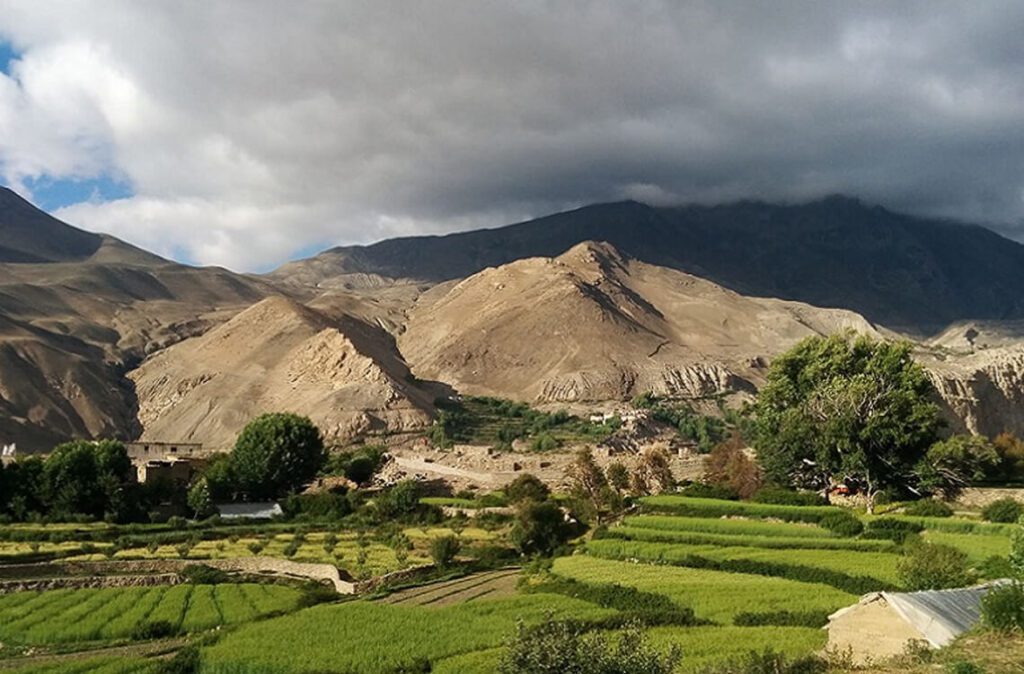
This trek starts from Jomsom and takes you through picturesque landscapes, traditional villages, and serene mountain trails. The trekking duration depends on the route you choose and your pace. It can range from 3–5 days or longer.
4. Helicopter
For those seeking a luxurious and time-saving option, helicopter tours are available from Kathmandu to Muktinath. You can charter a helicopter and enjoy breathtaking aerial views of the Himalayas while directly reaching Muktinath within a few hours.
Facts about Muktinath Temple:
- The temple is also known as Mukti Kshetra, which means “the place of liberation” or “the place of salvation.”
- The main deity of the temple is Lord Vishnu.
- The Muktinath area is mentioned in various Hindu scriptures, including the Barah Purana and the Skanda Purana.
- It is believed that visiting Muktinath and taking a holy bath in the nearby Mukti Kunda (water pond) can wash away sins and bring salvation.
- The temple attracts thousands of pilgrims from Nepal, India, and other parts of the world, especially during April to November.
- Muktinath Temple is also known for its natural beauty and breathtaking views of the surrounding mountains, including the Dhaulagiri and Annapurna ranges.
- The Jwala Mai Temple, located nearby, is famous for its eternal flame fueled by natural gas.
- The Muktinath area is a popular trekking destination, attracting adventure enthusiasts who combine spiritual pilgrimage with trekking.
- The temple complex showcases a blend of Hindu and Buddhist architecture, reflecting the harmony between the two religions in the region.
Best Time to Visit Muktinath
Let’s take a look at the best time to visit the Muktinath Temple, considering weather conditions, religious festivals, and personal preferences.
1. Spring (March to May)
Springtime brings a delightful ambiance to Muktinath, making it one of the best seasons to embark on your spiritual journey. The weather remains pleasantly warm during the day, allowing you to explore the temple complex comfortably.

Vibrant wildflowers adorn the surrounding landscape, creating a picturesque setting that enhances your visit. Moreover, the melting snow feeds nearby rivers and streams, offering breathtaking views and a soothing atmosphere.
2. Autumn (September to November)
The autumn months are one of the best seasons to visit the Muktinath Temple. The monsoon rains have ceased, leaving behind lush greenery and clear skies. The weather is mild and pleasant, with a crispness in the air that invigorates the soul.

This season also coincides with several major Hindu festivals, such as Dashain and Tihar, adding an extra layer of cultural vibrancy to your visit. Witnessing the local celebrations and traditions can be an enriching experience.
3. Winter (December to February)
While winter may bring chilly temperatures to the region, it offers a unique and tranquil atmosphere for those seeking solitude and introspection. The snow-capped peaks of the Annapurna and Dhaulagiri ranges provide a mesmerizing backdrop to the temple complex.
The fewer crowds during this time allow for a more personal connection with the spiritual essence of the place. However, it’s important to prepare for cold weather and potential snowfall, as they may affect your journey to the temple.
4. Monsoon Season (June to August)
The monsoon season brings heavy rainfall to Muktinath and the surrounding areas, which can make traveling to the temple challenging. The region experiences landslides and road closures, hindering accessibility.
However, if you don’t mind the rain and enjoy the lush green landscapes, this season can offer a unique perspective on the temple and its surroundings. It’s essential to check the weather and road conditions before planning a visit during the monsoon.
Accommodation
Let’s explore the accommodation near Muktinath Temple, unveiling the unique choices available:
1. The Serene Monastic Guesthouses
Muktinath boasts several monastic guesthouses that offer a distinct spiritual experience. Monks or nuns often manage these humble accommodations, offering visitors an opportunity to immerse themselves in the peaceful rhythm of monastic life.
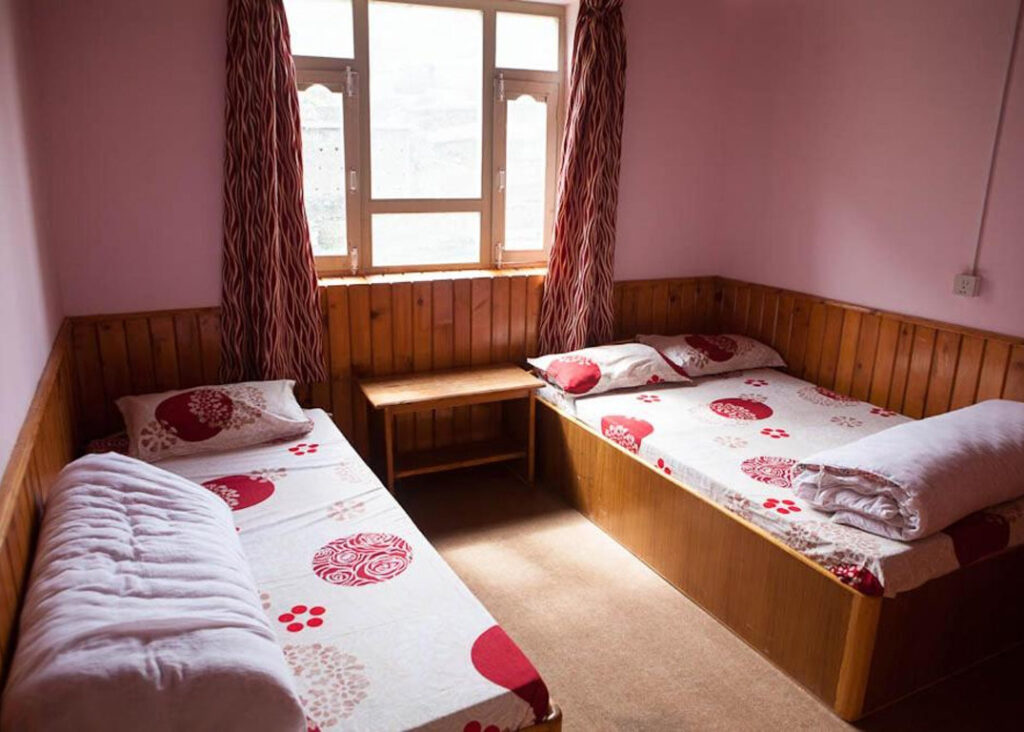
With their simplistic and tranquil ambiance, these guesthouses offer a space for introspection and meditation, allowing guests to connect with their inner selves.
2. Charming Teahouses and Lodges
For those seeking a taste of local culture and hospitality, teahouses and lodges around Muktinath Temple are a popular choice. These establishments provide cozy rooms with basic amenities, and their warm and welcoming atmosphere fosters a sense of camaraderie among fellow travelers.
Here, you can try delicious Nepali cuisine, sip on a steaming cup of tea, and engage in lively conversations with fellow pilgrims, creating lifelong memories.
3. Unique Homestays with Local Families
For an authentic cultural immersion, consider opting for a homestay experience with local families near Muktinath. This choice allows you to witness the daily lives of the people residing in this sacred region and gain insights into their traditions and customs.
Embrace the warmth and hospitality of your host family as they share their stories and local wisdom, creating a deep connection that transcends boundaries.
4. Camping in the Lap of Nature
If you crave an adventure amidst nature, camping near Muktinath Temple is an excellent option. The region offers several picturesque camping spots that allow you to sleep under the starry Himalayan sky.
Wake up to the crisp mountain air and breathtaking vistas, and relish the feeling of being in harmony with nature. Camping is an ideal choice for adventurous souls who seek solitude and a raw experience in the lap of the mighty Himalayas.
Tips
To make the most of your visit and ensure a smooth and fulfilling experience, here are some tips:
1. Acclimatize
Given its high altitude, it is crucial to acclimatize properly before visiting Muktinath. Spend a few days in Kathmandu or other lower-altitude destinations in Nepal to allow your body to adjust to the thin air.
2. Dress appropriately
The weather at Muktinath can be unpredictable, so it’s essential to dress in layers.

Carry warm clothing, including a jacket, hat, and gloves, as temperatures can drop significantly, especially in the early morning and evening.
3. Take It Slow
The journey to Muktinath involves a trek or drive through mountainous terrain. It’s advisable to take your time and pace yourself, especially if you’re not accustomed to high altitudes. Stay hydrated and rest whenever necessary to avoid altitude sickness.
4. Pack Essential Items
Make sure to carry essentials such as sunscreen, sunglasses, a hat, and comfortable walking shoes.
Interesting: Upper Mustang Trek in August: Weather, Difficulty, Travel Tips, and More
It’s also recommended to bring a water bottle, snacks, and a small first aid kit.
5. Stay Hydrated and Eat Well
Proper hydration and nutrition are crucial at high altitudes. Carry enough water with you and stay hydrated throughout the journey. Also, ensure you eat well-balanced meals to maintain your energy levels.
6. Consult a Local Guide
Hiring a local guide can enhance your experience by providing valuable insights into the religious and cultural significance of Muktinath. They can also assist with navigation and ensure a smoother journey.
Conclusion
Muktinath Temple isn’t just a destination—it’s a deeply spiritual journey surrounded by the breathtaking landscapes of the Himalayas. Whether you’re visiting for religious reasons, cultural exploration, or simply the adventure, the experience is both powerful and personal. The temple’s unique blend of Hindu and Buddhist significance, along with its remote location and high-altitude setting, makes it one of the most unforgettable places in Nepal.
However, planning a trip to Muktinath requires careful consideration. From choosing the right travel season to understanding routes, altitude challenges, and local customs, having accurate guidance can make a big difference. If you’re unsure where to start or want advice tailored to your needs, feel free to contact us—we’re happy to share local insights to help you plan a smooth and meaningful journey.
Let our expert team at Asian Heritage Treks and Travel take care of everything — from guided tours to personalized packing tips and travel arrangements.
Plan an exciting trip







